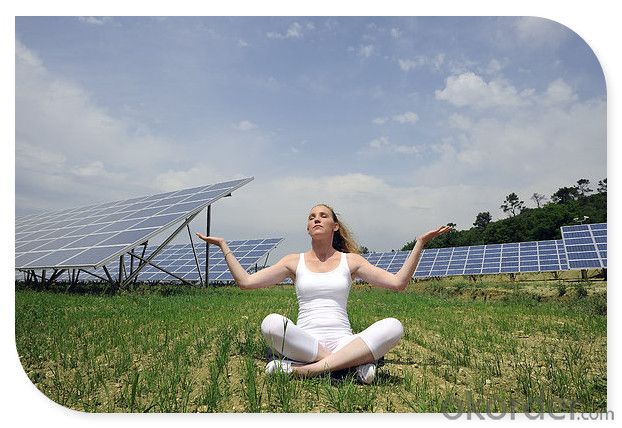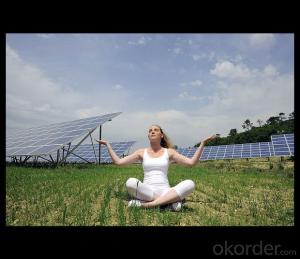Gaza Solar Panels - 300W Direct Factory Sale Price 260-300Watt Solar Panels
- Loading Port:
- China main port
- Payment Terms:
- TT OR LC
- Min Order Qty:
- 10000 watt
- Supply Capability:
- 100000 watt/month
OKorder Service Pledge
OKorder Financial Service
You Might Also Like
Specification



Solar Module Introduction
Solar modules use light energy (photons) from the sun to generate electricity through the photovoltaic effect. The majority of modules use wafer-based crystalline silicon cells or thin-film cells based on cadmium telluride or silicon. The structural (load carrying) member of a module can either be the top layer or the back layer. Cells must also be protected from mechanical damage and moisture. Most solar modules are rigid, but semi-flexible ones are available, based on thin-film cells. These early solar modules were first used in space in 1958.
Electrical connections are made in series to achieve a desired output voltage and/or in parallel to provide a desired current capability. The conducting wires that take the current off the modules may contain silver, copper or other non-magnetic conductive transition metals. The cells must be connected electrically to one another and to the rest of the system. Externally, popular terrestrial usage photovoltaic modules use MC3 (older) or MC4 connectors to facilitate easy weatherproof connections to the rest of the system.
Specification
Model Type | |
Peak Power-Pmax(W) | 5-200W |
Open Circuit Voltage-Voc(V) | 44.2 |
Maximum Power Voltage-Vmp(V) | 36 |
Short Circuit Current-Isc(A) | 5.4 |
Maximum Power Current-Imp(A) | 5 |
Maximum System Voltage | 1000V DC |
Maximum Series Fuse Rating | 10A |
Power Tolerance | -1~+3% |
Temperature Coefficients of Pmax | -0.45%/℃ |
Temperature Coefficients of Voc | -0.348%/℃ |
Temperature Coefficients of Isc | 0.031%/℃ |
Nominal Operating Cell Temperature | 44.5±2℃ |
Standard Testing Condition(STC) | Irradiance:1000W/m²;Temperature:25℃;AM=1.5 |
Qualification Test Parameters | |
Operating Temperature | -40℃~+85℃ |
Storage Temperature | -40℃~+85℃ |
Pressure Bearing | ≥5400Pascal/m² |
Wind Bearing | ≥5400Pascal/m² |
Mechanical Characteristics | |
Cell Size | Mono 125*125mm±0.5 |
No.of Cells | 72pcs(6*12) |
Dimension | 1580*808*40mm |
Weight | 15.5Kg |
Glass | 3.2mm High Transmission,Low Iron |
Frame | Anodized Aluminum Alloy |
Junction Box | IP65Rated |
Internal Diodes | 3 Bypass Diodes |
Cable | 1*4.0mm² Length 900mm |
Images
Packing & Shipping:
We have rich experience on how to pack the panels to make sure the safety on shipment when it arrives at the destination.
The normal size is packed by 25pcs/ carton / pallet. Paper carton for FCL shipping and wood carton for LCL shipping.
Features
1.High reliability with guaranteed -3% to +5% power output tolerance, ensuring return on investment
2.High conversion efficiency based on leading innovative photovoltaic technologies
3.Withstands high wind-pressure and snow load, and extreme temperature variations
4.Attractive appearanceUnique frame design, high mechanical strength, and easy Installation
Warranty:
For c-Si panel: 25years output warranty for no less than 80% of performance, 10 years output warranty for no less than 90% of performance. Free from material and workmanship defects within 5 years.
For a-Si panel: 20 years output warranty for no less than 80% of performance, 10 years output warranty for no less than 90% of performance. Free from material and workmanship defects within 2 years.
•100% product quality protection
•100% on-time shipment protection
•100% payment protection for your covered amount
FAQ:
(1)What price for each watt?
It depends on the quantity, delivery date and payment terms.
(2)What is your size for each module? Can you tell me the Parameter of your module?
We have different series of panels in different output, both c-Si and a-Si. Please take the specification sheet for your reference.
(3)Can you provide the peripheral products of the solar panels, such as the battery, controller, and inverter? If so, can you tell me how do they match each other?
Actually we are only manufacturer of solar panels, but we could try to source them for you in China if you need. We could provide you an optimal system design to instruct you how to install.
(4)Do you have the CE, TUV, UL Certification?
We’ve already passed all the tests, and any certificate is available.
(5)Have you ever sold your products to companies in my country?
Of course, we have customers in all general PV markets, but I think we should expand our market share along with the market growth.
(6)When did your company set up? You are a new company, how can I believe your quality?
We entered into Solar PV industry in 2005, now we have several plants in manufacturing of a-Si and c-Si panels, and our capacity is 220MW per year. Till now we have already passed all the tests by authorized laboratories, e.g. TUV, VDE, UL.
(7)Can you help us install the module if we cooperate with you?
We haven’t entered into installation sector, but we have the plan in near future.
(8) How do you pack your products?
We have rich experience on how to pack the panels to make sure the safety on shipment when it arrives at the destination.
(9) Can you do OEM for us?
Yes, we can.
(10)Can we visit your factory?
Surely, I will arrange the trip basing on your business schedule.
- Q: solar energy
- If you want to know how solar panels are made look here www.google.ca/search?hl=enq=how+... If you want to know how they are manufactured.
- Q: 200 watt solar panel generates how much watts of electricity per month?
- Theoretically, for every hour that bright, direct sun shines on the panel, 200 watt-hours (0.2 kWh) of energy will be produced. In practice, the answer depends on temperature, orientation of the panel, and how many hours of sun are hitting it, including clouds and seasons. This varies tremendously by geographic location. In my region of California, such a panel will produce about 33 kWh a month on average - more in summer, less in winter.
- Q: Can I add more solar panel let say up to 200 watt and adding two 2 volts battery using the same charges controller and power inverter?
- That charge controller is notoriously cheap and burns up easily. If you are going add solar panels, also buy another charge controller to go with them. They can both be connected to the same battery bank. I don't believe the kit comes with batteries, so you would buy whatever size 2V battery bank your power requirements call for. The size of the inverter depends entirely on what you are going to power with it, not the size of the panel array. As long as you are not powering anything that is over the 300W rating, you don't need a new one. Just be sure to check the details of the inverter, is it 300W continuous, or can it handle up to a 300W surge? Also, it's a modified sine wave inverter instead of a pure sine wave inverter, so don't plug any sensitive electronics into it. They may not work, or you may get a buzz or hum from it.
- Q: If I put a 5000 watt solar panel kit on my roof in Dublin (Ireland) - how much electricity would I realistically expect to get?An educated guess at a percentage of 5000w would do.
- Note that aiming is important - the sun is going to be perpendicular to the panels for only a few hours a year unless they are on an adjustable mount, so picking the time you most want power should be a factor in the angle they are mounted at - you can't keep the highest level of sun for summer into the winter time when the sun is much lower in the sky for a shorter time.
- Q: please no dumb answers and list where you got the info.Also how much does it cost to install solar panels for a regular sized house?
- Short version is that the sunlight knocks electrons loose from a semiconductor panel, and those loose electrons generate an electrical current. The solar panels have lots of cells arranged in series parallel to get to a higher voltage (usually 2 or 24 volts) and current. This is sent to charge batteries under the control of a charge controller. The voltage from the batteries is sent to an inverter that converts the 2/24 volts to 20/240 VAC for household usage. .
- Q: Can solar panels be installed on hiking trails or nature reserves?
- Yes, solar panels can be installed on hiking trails or nature reserves. However, certain considerations should be taken into account to minimize the environmental impact and ensure compatibility with the natural surroundings. Careful planning, appropriate technology, and consultation with relevant authorities are necessary to strike a balance between renewable energy generation and preservation of the ecosystem in these sensitive areas.
- Q: I've been figuring ways to keep water thawed out this winter, and this bucket seems to be the easiest thing. What kind of set up (solar panel) would I need to feed this 260 watt heated bucket?
- Unfortunately solar panels are low output,generally only 2 volt and very low amperage,so you would need to build a multi panel array with a DC-AC converter all together costing several hundred dollars which would only work during sunlight.Just roughly figuring,about $800. Plan2-Solar charger,battery bank,and DC-AC inverter so it would work 24hrs a day,also several hundred $$. Solar power does just not seem feasible(to me)in this application.By far the cheapest set up here would be an extension cord fromhouse to the bucket.260 watts per hr is a fairly lightweight draw,even not figuring the thermostat's cycling it on and off as needed.Electricity is sold in kilowatt hours(000W/hr).This bucket would use(not allowing for thermostats control lowering it)appx 6000watts or 6KW per day.Depending on your electrical cost per Kwh it would cost very little to run.(In my location appx 50cents a day) or appx the same amount as my computer(325watts total)) Note that that would be a maximum rate,and would actually be less due to thermostat cycling off and on as needed.
- Q: i am very new to the solar world and i need help with some stuff to understand what i need to do.what AH battery should i use? i am planning on getting a 2V deep cycle gel based battery but i want to get the most power for my system so should i use something like a few 00AH in a battery bank system or a bunch or 50 or so amp hour batteries in a bank. also what kind of power am i looking at for the best battery system. in other words what kind of basic appliances like lighting, laptop,space heaters etc can can i run on the selected battery system and for how long? any help would be highly appreciated.
- I'm sure that you might discover everything concerning solar power at www.okorder .
- Q: Can solar panels be installed on a residential community?
- Yes, solar panels can be installed on a residential community. Many residential communities have implemented solar panel systems to generate clean and renewable energy for homes. These installations can help reduce electricity costs, decrease reliance on fossil fuels, and contribute to a more sustainable living environment.
- Q: Just curious.
- Since you said does instead of do I think it would be fruitless trying to explain it...
Send your message to us
Gaza Solar Panels - 300W Direct Factory Sale Price 260-300Watt Solar Panels
- Loading Port:
- China main port
- Payment Terms:
- TT OR LC
- Min Order Qty:
- 10000 watt
- Supply Capability:
- 100000 watt/month
OKorder Service Pledge
OKorder Financial Service
Similar products
Hot products
Hot Searches
Related keywords



























